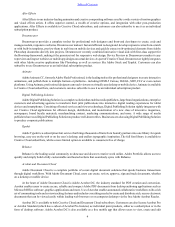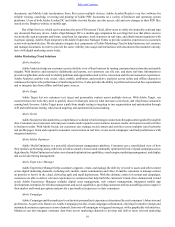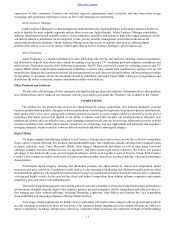Adobe 2015 Annual Report Download - page 19
Download and view the complete annual report
Please find page 19 of the 2015 Adobe annual report below. You can navigate through the pages in the report by either clicking on the pages listed below, or by using the keyword search tool below to find specific information within the annual report.
Table of Contents
19
or applications. The most common Internet browsers allow consumers to modify their browser settings to prevent cookies from
being accepted by their browsers, or are set to block third-party cookies by default. Increased use of methods, software or applications
that block cookies could harm our business.
For additional information regarding our competition and the risks arising out of the competitive environment in which
we operate, see the section entitled “Competition” contained in Part I, Item 1 of this report.
If we fail to successfully manage transitions to new business models and markets, our results of operations could suffer.
We often release new offerings and employ new product and services delivery methods in connection with our diversification
into new business models and markets. It is uncertain whether these strategies will prove successful or whether we will be able to
develop the necessary infrastructure and business models more quickly than our competitors. Market acceptance of new product
and service offerings will be dependent in part on our ability to (1) include functionality and usability that address customer
requirements, and (2) optimally price our products and services in light of marketplace conditions, our costs and customer demand.
New product and service offerings may increase our risk of liability related to the provision of services and cause us to incur
significant technical, legal or other costs. For example, with our cloud-based services and subscription-based licensing models,
such as Creative Cloud, we have entered markets that may not be fully accustomed to cloud-based subscription offerings. Market
acceptance of such services is affected by a variety of factors, including information security, reliability, performance, customer
preference, social and community engagement, local government regulations regarding online services and user-generated content,
the sufficiency of technological infrastructure to support our products and services in certain geographies, customer concerns with
entrusting a third party to store and manage its data, consumer concerns regarding data privacy and the enactment of laws or
regulations that restrict our ability to provide such services to customers in the United States or internationally. If we are unable
to respond to these threats, our business could be harmed.
From time to time we open-source certain of our technology initiatives, provide broader open access to our technology,
license certain of our technology on a royalty-free basis, or release selected technology for industry standardization. Additionally,
customer requirements for open standards or open-source products could impact adoption or use of some of our products or services.
To the extent we incorrectly predict customer requirements for such products or services, or if there is a delay in market acceptance
of such products or services, our business could be harmed.
We also devote significant resources to the development of technologies and service offerings in markets where our operating
history is less extensive, such as the marketplace for stock imagery. These new offerings and markets may require a considerable
investment of technical, financial, compliance and sales resources, and a scalable organization. Some of our competitors may have
advantages over us due to their larger presence, larger developer network, deeper market experience and larger sales, consulting
and marketing resources. In addition, the metrics we use to gauge the status of our business model transition may evolve over the
course of the transition as significant trends emerge. If we are unable to successfully establish new offerings in light of the
competitive environment, our results of operations could suffer.
Subscription offerings and ETLAs could create risks related to the timing of revenue recognition.
Our subscription model creates certain risks related to the timing of revenue recognition and potential reductions in cash
flows. A portion of the subscription-based revenue we report each quarter results from the recognition of deferred revenue relating
to subscription agreements entered into during previous quarters. A decline in new or renewed subscriptions in any period may
not be immediately reflected in our reported financial results for that period, but may result in a decline in our revenue in future
quarters. If we were to experience significant downturns in subscription sales and renewal rates, our reported financial results
might not reflect such downturns until future periods. Our subscription model could also make it difficult for us to rapidly increase
our revenue from subscription-based or hosted services through additional sales in any period, as revenue from new customers
will be recognized over the applicable subscription term. Further, any increases in sales under our subscription sales model could
result in decreased revenue over the short term if they are offset by a decline in sales from perpetual license customers.
Additionally, in connection with our sales efforts to enterprise customers and our use of ETLAs, a number of factors could
affect our revenue, including longer than expected sales and implementation cycles, potential deferral of revenue due to multiple-
element revenue arrangements and alternate licensing arrangements. If any of our assumptions about revenue from our new
businesses or our addition of a subscription-based model prove incorrect, our actual results may vary materially from those
anticipated, estimated or projected.
Uncertainty about current and future economic conditions and other adverse changes in general political conditions in any of
the major countries in which we do business could adversely affect our operating results.
As our business has grown, we have become increasingly subject to the risks arising from adverse changes in economic
and political conditions, both domestically and globally. Uncertainty about the effects of current and future economic and political
























